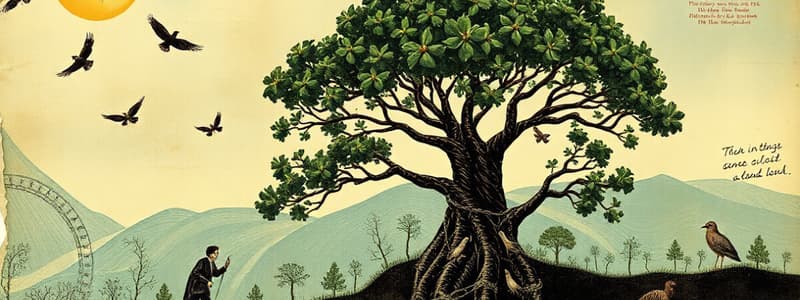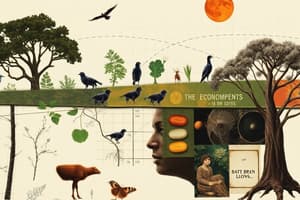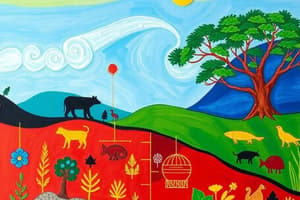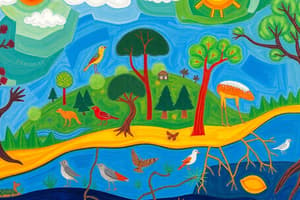Podcast
Questions and Answers
What is the term for a group of individuals of the same species living in the same geographical area?
What is the term for a group of individuals of the same species living in the same geographical area?
- Community
- Population (correct)
- Ecosystem
- Biosphere
The influence of abiotic factors on biotic factors is called a reaction.
The influence of abiotic factors on biotic factors is called a reaction.
False (B)
What is the key difference between a community and an ecosystem?
What is the key difference between a community and an ecosystem?
A community consists of interacting populations, while an ecosystem includes the community and its abiotic environment.
The relationship between organisms in an ecosystem can be described as ______.
The relationship between organisms in an ecosystem can be described as ______.
A food chain represents a simple, linear series of predator-prey relationships in an ecosystem.
A food chain represents a simple, linear series of predator-prey relationships in an ecosystem.
Match the following terms with their definitions:
Match the following terms with their definitions:
Which of the following is NOT an example of an abiotic factor?
Which of the following is NOT an example of an abiotic factor?
Why is the term 'food web' often used instead of 'food chain'?
Why is the term 'food web' often used instead of 'food chain'?
Which of the following organisms are NOT primary consumers?
Which of the following organisms are NOT primary consumers?
Producers are organisms that obtain their energy from consuming other organisms.
Producers are organisms that obtain their energy from consuming other organisms.
What is the term used to describe animals that eat primarily plants?
What is the term used to describe animals that eat primarily plants?
Animals at the highest trophic levels are known as ______.
Animals at the highest trophic levels are known as ______.
Which of the following is NOT a factor that limits the population growth of apex predators?
Which of the following is NOT a factor that limits the population growth of apex predators?
Match the following trophic levels with their corresponding organisms:
Match the following trophic levels with their corresponding organisms:
What is the primary source of energy for most food chains?
What is the primary source of energy for most food chains?
In aquatic ecosystems, algae are the producers, while animal plankton are the primary consumers.
In aquatic ecosystems, algae are the producers, while animal plankton are the primary consumers.
The successive levels of feeding relationships in an ecosystem are called ______ levels.
The successive levels of feeding relationships in an ecosystem are called ______ levels.
Which of the following statements is true about food chains in the soil?
Which of the following statements is true about food chains in the soil?
Flashcards
Ecosystem
Ecosystem
A system made of a community and abiotic components.
Population
Population
A group of individuals of the same species in one area.
Community
Community
A group of populations interacting in the same area.
Interactions
Interactions
Signup and view all the flashcards
Interspecific Interaction
Interspecific Interaction
Signup and view all the flashcards
Predator-Prey Relationship
Predator-Prey Relationship
Signup and view all the flashcards
Food Chain
Food Chain
Signup and view all the flashcards
Food Web
Food Web
Signup and view all the flashcards
Producers
Producers
Signup and view all the flashcards
Consumers
Consumers
Signup and view all the flashcards
Primary Consumers
Primary Consumers
Signup and view all the flashcards
Secondary Consumers
Secondary Consumers
Signup and view all the flashcards
Trophic Levels
Trophic Levels
Signup and view all the flashcards
Quaternary Consumers
Quaternary Consumers
Signup and view all the flashcards
Environmental Resistance
Environmental Resistance
Signup and view all the flashcards
Apex Predators
Apex Predators
Signup and view all the flashcards
Herbivores
Herbivores
Signup and view all the flashcards
Study Notes
Ecosystem Structure
- Ecosystem: A system comprising a community and its abiotic environment.
- Population: A group of the same species in the same area.
- Community: Populations of different species interacting together.
- Interspecific Interaction: How populations of different species affect each other. Includes competition, symbiosis, and predation.
Food Chains and Food Webs
- Food Chain: A series of organisms linked by predator-prey relationships (eat-be eaten).
- Predator: An organism that eats another.
- Prey: An organism that is eaten.
- Food Web: Multiple interconnected food chains forming a complex network. Arrows show the direction of energy flow.
- Producers: Organisms that produce their own food (e.g., plants through photosynthesis).
- Consumers: Organisms that eat other organisms. Classified by trophic levels.
- Primary Consumers: Herbivores that eat producers.
- Secondary Consumers: Carnivores that eat primary consumers.
- Tertiary Consumers: Carnivores that eat secondary consumers.
- Quaternary/Quinary Consumers: Eat tertiary/quaternary consumers, respectively.
- Trophic Levels: Positions in a food chain based on nutrition intake. Higher levels have more energy.
- Examples:
- Land: Plants > Herbivores > Carnivores; Golden Eagle/Sea Lions are examples of higher level consumers.
- Soil: Fallen leaves/roots > Earthworms > Mites; Plants are the base.
- Water: Algae > Plankton > Fish > Sharks; Algae are producers in water.
- Herbivores have adaptations for eating plants (teeth, digestive system) and predator avoidance. Carnivores have adaptations for catching prey.
Ecosystem Dynamics
- Environmental Resistance: Factors that limit population growth e.g., decreased food, illness, fewer offspring or eggs, impacting animals at higher trophic levels, like apex predators/top consumers.
- Species Survival: Species, even when prey, are not necessarily diminished; their higher numbers and reproduction capacities prevent complete eradication.
Studying That Suits You
Use AI to generate personalized quizzes and flashcards to suit your learning preferences.




